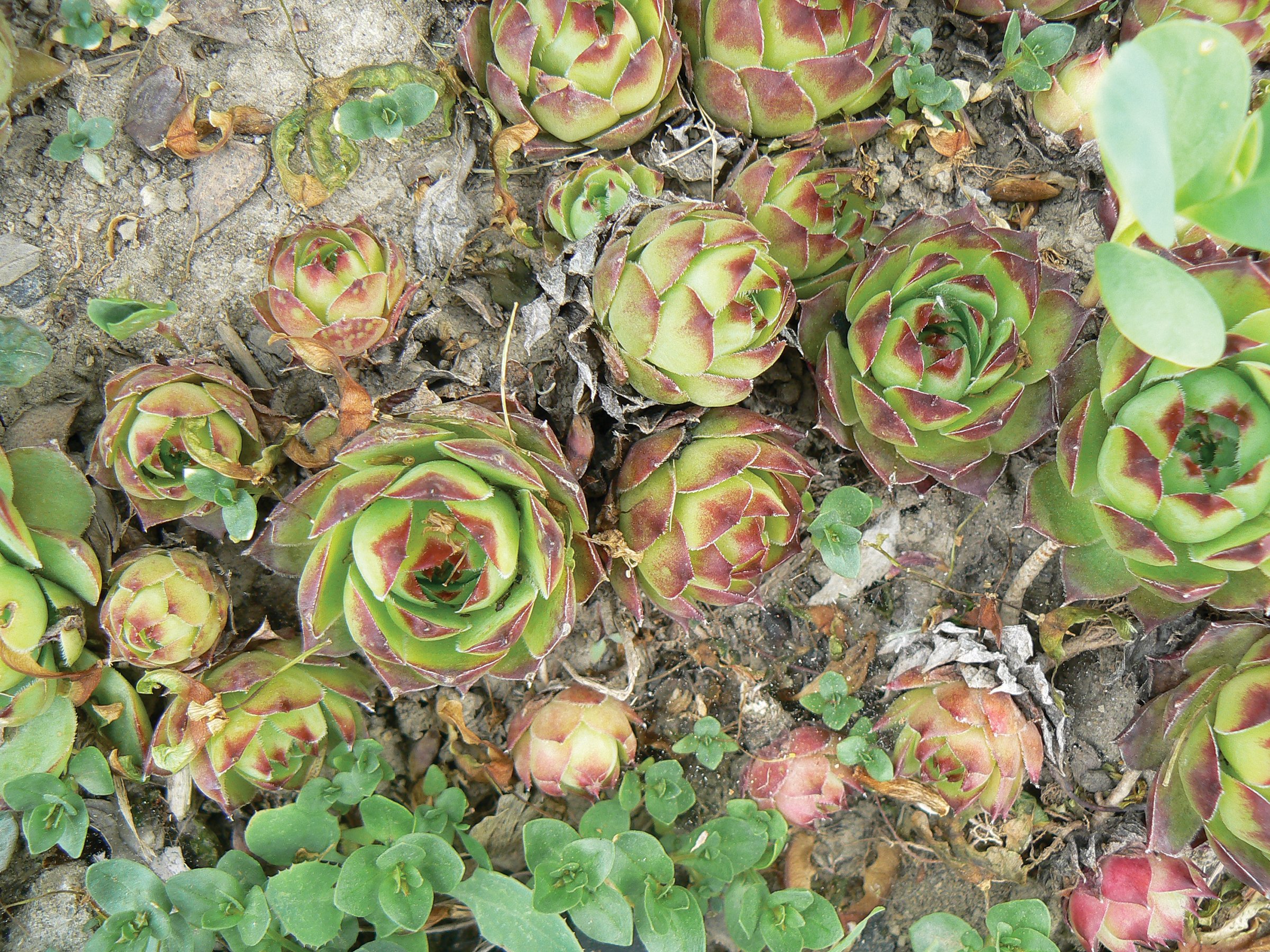GET GROWING!
GREENLIGHT YOUR GARDENING YEAR!
Houseleeks, or what we know as hens and chicks. Emperor Charlemagne believed they warded off lightning strikes, fire and evil.
By LADYBUG
Anyone who gardens in these northern climes knows that English gardens follow a different calendar. Gardens in England, that is, not the style – lots of colourful flowers and edible plants in no formal plan – that is described as an English or cottage garden.
Gardens in England, it is evident, aren’t exactly in step with ours, seeing as how in England they step out into fields of bluebells in March when everything around us is frozen hard.
Just take a look at these “key tasks” for January – January !– from Your Gardening Year:
• Protect vulnerable plants from severe weather.
• Hoe any germinating weeds.
• Dig over soil, as conditions allow.
• Brush snow off trees, shrubs and hedges.
• Take hardwood cuttings of trees and shrubs, and root cuttings from perennials.
• Sow some summer bedding under cover.
• Check bulbs being forced.
• Start sowing early vegetable crops under cover.
...and I rest my case.
But by around April, if we’re lucky that year, or early May, our gardens catch up. Because our gardening year may be squished into six short months, but we do enjoy many of the same plants.
May’s key tasks resemble my to-do list for the month.
• Protect tender plants from late frosts.
• Trim any formal hedging lightly.
• Protect young plants from slugs and snails.
• Clear out spring bedding to make space for summer bedding plants.
• Move tender pants outside now for the summer.
• Sow and plant tender vegetables outdoors, and continue successional sowing of vegetables.
• Ventilate greenhouses or conservatories during warmer weather.
This beautifully illustrated book is a guide that one can dip into for expert advice on everything from tasks around the garden to containers and the kitchen garden to how to get ahead for the next year – gardeners are always looking ahead!
* * *
During a cold, dark winter – yes, much like this one, you might say – Kristyna Baczynski was gripped by seasonal gloom, she writes in her introduction.
“I started taking walks around my neighbourhood to shake up my motivation and noticed little plants thriving despite the frosty bleakness. What were these intrepid leaves? How could they prosper when everything else seemed to have faded? Those brave weeds reignited my curiosity and enthusiasm; I wanted to explore and discover.; to document and research, to write and illustrate.”
Baczynski self-published a pocket-size zine that collected her favourtie plants and their fascinating histories. The illustrator, comic book artist and author went on to make a zine for every season and together, they became an early version of The Wild Year.
She draws me in into her world with the very first entry, wintergreen, the hardy plant that is native to Canada.
She describes another shrubby tree that is a common sight in these parts – staghorn sumac – in almost poetic terms.
The fruit cones remain on female trees, deep burgundy torches that smolder in the wintry darkness.
She details how it can be used fresh in lemonade or dried and crushed to make the popular spice.
I discover an old favourite, Honesty, or Lunaria annual, which my friend and gardening guru Dorothy called silver dollar because of the papery silver seedpods.
The book informs me that in Denmark it is known by yet another name: judaspenge or coins of judas. “One person’s honesty is another person’s biblical betrayal.”
The book is packed with info on plants that you may think you know. Houseleeks, or what we know as hens and chicks. Articles on green roofs that extol the virtues of succulent, low maintenance plants often include hens and chicks. But did you know that its scientific name, semprvivum tectorum, means the ever-living roof? Or that “in the eighth century, Emperor Charlemagne decreed in his Capitulare de Villis – a governance guide for royal estates – that houseleeks be planted on every rooftop to ward off lightening strikes, fire and evil”?
While it may offer only mythical protection against the elements, its leaves contain juices that can be used to treat burned and swollen skin. And I thought only aloe did that!
From oxalis, juniper, primrose, violets, trillium, thrift to wild bee balm, foxgloves, yarrow...from spring to summer, I learn fascinating things about so many plants.
So stay with her as she wanders near and far, and you’ll be rewarded with a treat of a book, brimming with wondrous wildflowers and plants, foraging tips, scientific and folkloric information. The illustration that accompanies her description – Kristyna lives in Leeds, UK, with her husband, cat, and a small but wild garden – only adds to the connect.
A note on foraging: Baczynski cautions that while foraging can be “an amazing way to enjoy seasonal plants, it can also be dangerous as misidentification may lead to interaction with irritants and ingestion of toxic matter.
“It’s always worth foraging with someone who is experienced, knowledgeable, and confident in identifying local plants.”
Your Gardening Year, illustrated by Alice Pattullo, is published by DK, $25.99.
The Wild Year by Kristyna Baczynski is published byTarcher Perigee, $24.95.



